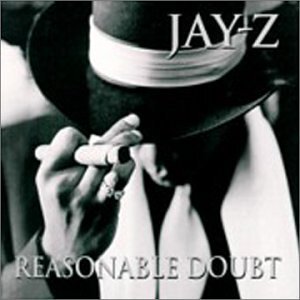A Look Into Reasonable Doubt 25 Years Later

We all know the story of how a drug dealer from Marcy Projects became one of the—scratch that—THE greatest rapper of all time. Yet that story doesn’t begin without Reasonable Doubt. Jay-Z’s debut LP is the blueprint (no pun intended) to understanding his career, and for many, one to follow generations later.
Reasonable Doubt is the genesis of the Roc-A-Fella empire. In what was originally intended to be his only album before stepping into an executive role, it ultimately led to Jay-Z becoming an immortal figure in music.
“The whole album is like a diary for me” Jay states in a 1996 interview on Flipping Da Script. From hustling in the streets to finally releasing an album, this is a celebration for Jay. Since the late 80’s, he’s been trying to breakthrough in the music industry.
Hustling was his main gig though; it just so happened that he knew how to rap too. Jaz-O would take Jay under his wing before being dropped by his label. Jigga’s flow at first was rapid. He would make syllables bounce off each other like a machine gun.
The tongue-twisting new jack style of rap was first popularized by the likes of Das EFX. He would end up landing a spot on the Billboard Maxi charts by appearing on Original Flavor’s hit “Can I Get Open?”.
Despite being on tour with the legendary Big Daddy Kane, Jay was still unsigned. The lack of support from Payday Records for his first solo single “In My Lifetime” led Jay to take matters into his own hands. The young MC would continue to sell tapes from his car and eventually start up Roc-A-Fella Records with Dame Dash and Kareem “Biggs” Burke. At a time where Bad Boy and Death Row were the dominant hip-hop labels, it was rare for a company to be independent on a large scale.
His first single, “Dead Presidents,”marked a new beginning for Jay. No longer was he the young kid next to Jaz-O in the Hawaiian shirt.
His game had grown now with a slower, more composed yet effortless flow. Everything about “Dead Presidents” is the perfect illustration of the pursuit of the almighty dollar. We all want money like Cosby. Playing Monopoly with real cash isn’t just a dope bar; it’s real life.
The end scene with Jay, The Notorious B.I.G., and AZ around the table stacking bricks of cash will forever be iconic. It’s still hard to fathom that this version didn’t make the album. Instead, he adds an aggressive remix of the track. You can hear the hunger and confidence exuding on the Ski instrumental. He even signs his name in the middle of a verse!
“Dead Presidents II” was the first song I purchased on iTunes. Remember those days?
The album started off with Pain in Da Ass giving his best Tony Montana impersonation before Jay steps into his Don Juan DeMarco Godfather flow with Mary J. Blige. From tracks 1 to 14, he paints the story of the highs and lows of the drug game before finishing on top. Biggie and Hov trading bars in unison on “Brooklyn’s Finest” is something I would kill to go back in time to witness.
On tracks such as “Feeling It,” “D’Evils,” and “Can I Live,” Jay points out the duality of the fast life. There are samples from Snoop and Prodigy to depict the corruption of money and risk that comes with it.
He expresses vulnerability and paranoia but shows the flipside of the luxuries that money brings. “Can I Live” is a story about longtime friend Emory Jones’ epic night in Vegas. Despite what life throws at us, it’s still worth celebrating. The women, cashmere, and Cristal explained on “Ain’t No” and “Cashmere Thoughts” aren’t a bad formula for a great night.
“22 Two’s” is based on Jay performing on Mad Wednesday—an event in Harlem that helped Jay-Z and other rising artists grow their fanbase. At the end of the track, host Maria Davis explains the importance of Blacks building their businesses and putting money into Black-owned companies. Nearly foreshadowing the line “clothing, movie, and films we come to conquer it all”.
At the end of the album, he rides into the sunset reflecting on his journey learning a big life lesson—living with regrets.
Combining the machismo and silk bravado of Jay with Clark Kent, Premier, and Ski on production creates this masterpiece. The LP earned 4 and a half mics from The Source and spent 55 weeks on the Billboard Hip-Hop/R&B charts. However, 1996 was a golden year in hip-hop. 2Pac, The Fugees, Nas, Lil Kim, and Outkast are some notable artists who dropped monumental albums.
It’s easy to be overlooked by these established stars as a rising artist. It wasn’t until 2002, when Jay-Z was at peak of his career, when Reasonable Doubt reached platinum status despite the great reception.

Reasonable Doubt has taken the Roc and hip-hop to many great places, but it will always be Brooklyn’s own. 25 years later, it holds the title of Hov’s best project and one of the greatest rap albums of all-time. I’m not going to argue with the man if he said it himself. The album speaks to you in a way only Jay can deliver. The game he gives isn’t too preachy as it’s spoon-fed throughout each song. It’s a how-to on the journey of success. To this day you can still apply the lessons and codes in different areas of life outside of the rap and drug game. Reasonable Doubt will undoubtedly remain as the standard of Jay-Z’s sound and the bar for debut projects from all others.
